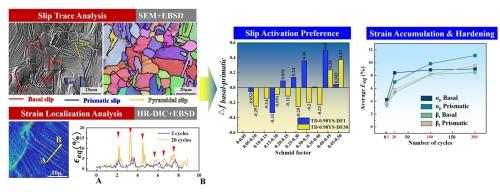Comparative study of slip activities and strain distribution in Ti6321 alloy with bimodal microstructure under dwell fatigue loadings
IF 6.8
2区 材料科学
Q1 ENGINEERING, MECHANICAL
引用次数: 0
Abstract
Near-α titanium alloys are known to be susceptible to dwell fatigue debit, which has been linked to microstructure and the microscale slip deformation localization. However, prior research has predominantly focused on primary α (αp) microstructures, leaving a critical gap in systematic investigations of bimodal microstructures, which are of greater engineering relevance. This study systematically investigates slip activation mechanisms in Ti6321 alloy under pure fatigue and dwell-fatigue loading through integrated slip trace analysis and high-resolution digital image correlation (HR-DIC), focusing on αp and secondary α (αs) colony in transformed β (βt) microstructures. Key findings revealed that dwell-fatigue conditions significantly enhance basal and prismatic slip activation compared to pure fatigue, elevating plastic strain localization within slip bands. Hexagonal close-packed (HCP) elastic anisotropy and the superior strain rate sensitivity (SRS) of basal slips drive preferential activation across both hard- and soft-oriented regions, while prismatic slips exhibit sustained strain accumulation due to lower strain hardening. Furthermore, comparing to the αp, analysis demonstrates that αs colony prevent long-range slip through strain dispersion at interface, reducing dwell sensitivity. These results provide crystallographic insights into the mechanistic linkage between dwell fatigue effects and slip-mediated deformation, offering critical guidance for microstructure-informed alloy design and crystal plasticity model calibration.

双峰组织Ti6321合金在疲劳载荷下滑移活动与应变分布的对比研究
近α钛合金易发生蠕变疲劳,这与微观组织和微尺度滑移变形局部化有关。然而,先前的研究主要集中在初级α (αp)微观结构上,对双峰微观结构的系统研究存在重大空白,而双峰微观结构具有更大的工程意义。本研究通过综合滑移迹分析和高分辨率数字图像相关(HR-DIC)技术,系统研究了Ti6321合金在纯疲劳和持久疲劳载荷下的滑移激活机制,重点研究了相变β (βt)组织中的αp和次生α (αs)菌落。主要研究结果表明,与纯疲劳相比,居住疲劳条件显著增强了基底和棱柱滑移激活,提高了滑移带内的塑性应变局部化。基卡瓦的六方紧堆积(HCP)弹性各向异性和优越的应变率敏感性(SRS)驱动了硬取向和软取向区域的优先激活,而柱卡瓦由于较低的应变硬化而表现出持续的应变积累。此外,与αp相比,αs菌落通过界面应变色散阻止了长时间的滑移,降低了驻留灵敏度。这些结果为驻留疲劳效应和滑移介导变形之间的机制联系提供了晶体学上的见解,为微结构合金设计和晶体塑性模型校准提供了重要指导。
本文章由计算机程序翻译,如有差异,请以英文原文为准。
求助全文
约1分钟内获得全文
求助全文
来源期刊

International Journal of Fatigue
工程技术-材料科学:综合
CiteScore
10.70
自引率
21.70%
发文量
619
审稿时长
58 days
期刊介绍:
Typical subjects discussed in International Journal of Fatigue address:
Novel fatigue testing and characterization methods (new kinds of fatigue tests, critical evaluation of existing methods, in situ measurement of fatigue degradation, non-contact field measurements)
Multiaxial fatigue and complex loading effects of materials and structures, exploring state-of-the-art concepts in degradation under cyclic loading
Fatigue in the very high cycle regime, including failure mode transitions from surface to subsurface, effects of surface treatment, processing, and loading conditions
Modeling (including degradation processes and related driving forces, multiscale/multi-resolution methods, computational hierarchical and concurrent methods for coupled component and material responses, novel methods for notch root analysis, fracture mechanics, damage mechanics, crack growth kinetics, life prediction and durability, and prediction of stochastic fatigue behavior reflecting microstructure and service conditions)
Models for early stages of fatigue crack formation and growth that explicitly consider microstructure and relevant materials science aspects
Understanding the influence or manufacturing and processing route on fatigue degradation, and embedding this understanding in more predictive schemes for mitigation and design against fatigue
Prognosis and damage state awareness (including sensors, monitoring, methodology, interactive control, accelerated methods, data interpretation)
Applications of technologies associated with fatigue and their implications for structural integrity and reliability. This includes issues related to design, operation and maintenance, i.e., life cycle engineering
Smart materials and structures that can sense and mitigate fatigue degradation
Fatigue of devices and structures at small scales, including effects of process route and surfaces/interfaces.
 求助内容:
求助内容: 应助结果提醒方式:
应助结果提醒方式:


